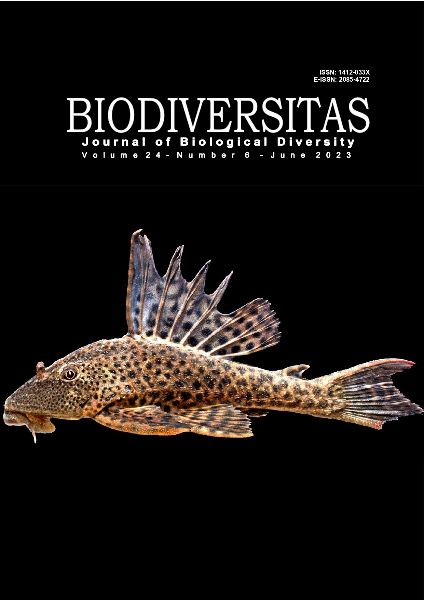Caffeine degradation by food microorganisms
##plugins.themes.bootstrap3.article.main##
Abstract
Abstract. Purwoko T, Suranto, Setyaningsih R, Marliyana SD. 2023. Caffeine degradation by food microorganisms. Biodiversitas 24: 3495-3502. Commercial coffee beans are dominated by robusta and arabica coffee beans. Caffeine is one of the important components in coffee beans. Caffeine has antimicrobial effect. Caffeine content in robusta beans was higher than in arabica beans. Caffeine content in coffee beans was affected by the coffee species, the coffee cultivation's altitude and the postharvest processing method. Microbial fermentation activity could reduce the caffeine content of coffee beans. Lactobacillus casei, Leuconostoc mesenteroides, Rhizopus oryzae and Saccharomyces cerevisiae, were able to reduce caffeine content of robusta beans. This study aimed to determine the degradation pathway of caffeine by food microorganisms, namely L. casei, L. mesenteroides, R. oryzae and S. cerevisiae. Caffeine content in NB-caffeine and PDB-caffeine media were reduced by L. casei, L. mesenteroides, R. oryzae and S. cerevisiae. Caffeine was transformed into dimethylxanthine and then into methylxanthine by L. casei, L. mesenteroides, R. oryzae and S. cerevisiae. They transformed more than 89% caffeine into paraxanthine, however, small amount of paraxanthine was transformed into methylxanthine. L. casei and L. mesenteroides transformed paraxanthine into 1-methylxanthine. However, R. oryzae and S. cerevisiae transformed into 7-methylxanthine. There were two patterns of degradation of caffeine into methylxanthine i.e., caffeine-paraxanthine-1-methylxanthine and caffeine-paraxanthine-7-methylxanthine. The first was shown by L. casei and L. mesenteroides, and the last by R. oryzae and S. cerevisiae.
##plugins.themes.bootstrap3.article.details##
Most read articles by the same author(s)
- ARTINI PANGASTUTI, RIZAL KHOIRUN ALFISAH, NUR IFFAH ISTIANA, SITI LUSI ARUM SARI, RATNA SETYANINGSIH, ARI SUSILOWATI, TJAHJADI PURWOKO, Metagenomic analysis of microbial community in over-fermented tempeh , Biodiversitas Journal of Biological Diversity: Vol. 20 No. 4 (2019)
- SITI LUSI ARUM SARI, ARTINI PANGASTUTI, ARI SUSILOWATI, TJAHJADI PURWOKO, EDWI MAHAJOENO, WAHYU HIDAYAT, IKOW MARDHENA, DEWI KURNIAWATI, ROBIAH ANITASARI, Cellulolytic and hemicellulolytic bacteria from the gut of Oryctes rhinoceros larvae , Biodiversitas Journal of Biological Diversity: Vol. 17 No. 1 (2016)
- NOOR SOESANTI HANDAJANI, TJAHJADI PURWOKO, The activity of galanga (Alpinia galanga) rhizome extract against the growth of filamentous fungi Aspergillus spp. that produce aflatoxin and Fusarium moniliforme , Biodiversitas Journal of Biological Diversity: Vol. 9 No. 3 (2008)
- TJAHJADI PURWOKO, NOOR SOESANTI HANDAJANI, Protein concentrations of sweet soysauces from Rhizopus oryzae and R. oligosporus fermentation without moromi fermentation , Biodiversitas Journal of Biological Diversity: Vol. 8 No. 3 (2007)
- TJAHJADI PURWOKO, SURANTO, RATNA SETYANINGSIH, SOERYA DEWI MARLIYANA, Chlorogenic acid and caffeine content of fermented robusta bean , Biodiversitas Journal of Biological Diversity: Vol. 23 No. 2 (2022)
- SLAMET SANTOSA, SUTARNO SUTARNO, EDI PURWANTO, SURANTO SURANTO, SAJIDAN SAJIDAN, Molecular characterization of Plant Growth Promoting Rhizobacteria using 16S rRNA sequences in the organic rice field of Sukorejo Village, Central Java, Indonesia , Biodiversitas Journal of Biological Diversity: Vol. 19 No. 6 (2018)
- SURANTO SURANTO, Application of Modern Experimental Technique to Solve Morphological Complexity in Plants Taxonomy , Biodiversitas Journal of Biological Diversity: Vol. 1 No. 2 (2000)
- SITI LUSI ARUM SARI, RATNA SETYANINGSIH, NOVITA FITRIATUL AINI WIBOWO, Isolation and screening of cellulolytic fungi from Salacca zalacca leaf litter , Biodiversitas Journal of Biological Diversity: Vol. 18 No. 3 (2017)
- SURANTO SURANTO, A.T. SYAHIDAH, EDWI MAHADJOENO, Variation of morphology, anatomy and nutrition contents of local cultivar mentik rice based on the altitudes at Ngawi District, East Java, Indonesia , Biodiversitas Journal of Biological Diversity: Vol. 19 No. 2 (2018)
- FAJAR RAHMAH NURAINI, RATNA SETYANINGSIH, ARI SUSILOWATI, Screening and characterization of endophytic fungi as antagonistic agents toward Fusarium oxysporum on eggplant (Solanum melongena) , Biodiversitas Journal of Biological Diversity: Vol. 18 No. 4 (2017)

